#but the pink dolphin that eats people myth
Explore tagged Tumblr posts
Text
I will fight anyone to the death that Shiny Leafeon should’ve been orange like an autumn leaf
#and Glaceon being black for black ice or a deeper glacier blue#Shiny espeon has grown on me because alien green#however if it was related to the sun it should’ve been themed after a solar eclipse#but I think they focused on the psychic aspect of Espeon this time#jolteon also should be blue or a stormy gray#flareon purple or blue but only blue if jolteon is not blue#or green because green fire exists#like chemical fires and all that#sprite spam#rest of them are fine#I would maybe tweak vaporeon to be more pinker because pink dolphin#but the pink dolphin that eats people myth
10 notes
·
View notes
Note
Now I can't stop infodumping, but Iara, that Anon mentioned, is also a very cool case, because folklorists say she's probably based on indigenous tales about Cobra Grande (giant river snake) and variants, which are another favorite for me! In indigenous mythologies, Cobra Grande is often dangerous, drowning and eating people like Iara, but it also has children with indigenous folks and is part of many creation myths like the origin of night and rivers. How did that turn into a mermaid, right??
It's fascinating! Especially since the exact origins are so hard to trace.
The book on water spirits I have talks of "Oiára" and calls them beautiful water maidens with long black hair that they with entwine morenú flowers and that have the tail of a porpoise. They lure young men with their song, embrace them and drown them.
But then someone else names the Uauyará, who is male but transforms himself into either a river porpoise or a handsome man who seduces women. Which sounds more like the shapeshifting boto/pink river dolphin. (Maybe he is also a descendant of the Cobra Grande?)
Another entry calls the Yara a "water-witch" and states that her singing causes a sort of sickening, melancholy longing that causes their victims to join her in the water.
The Langs included a story about a Yara in The Brown Fairy Book (1904), adapted from Folklore Bresilien. But you never know how much adaptation was done with those books. Because in this story the young man that is the Yara's intended victim, is saved by his beloved, who gives him a seashell which she sings a song into, so he can drown out the song of the Yara. Which is intensely romantic but does not quite feel fitting with the other folklore snippets about how dangerous these Brazillian mermaidens are...
#brazillian folklore#yara#iara#mermaids#foklore#mermay#because it still is!#ask#mirror-of-too-many-books#laura babbles
28 notes
·
View notes
Text
14 Fun Facts About Bright Pink Animals
https://sciencespies.com/nature/14-fun-facts-about-bright-pink-animals/
14 Fun Facts About Bright Pink Animals
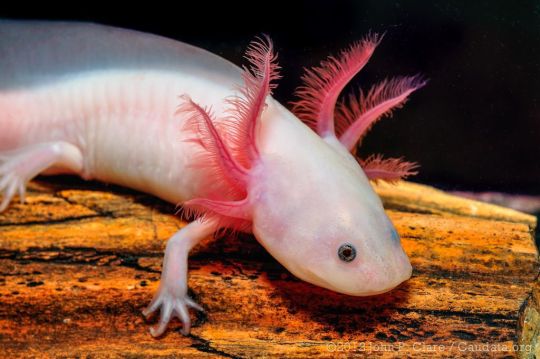
SMITHSONIANMAG.COM | Feb. 12, 2021, 6:08 p.m.
Each February, the color pink is a bold sign that the season of love has arrived. Now filled with blush-colored Hallmark cards featuring cute puppies and kittens, Valentine’s Day has evolved in stark contrast to its origins. The three-day Roman feast allegedly marked by animal sacrifice is certainly more R-rated by today’s standards.
Thankfully, people simply purchase fluffy, rose-tinted Teddy bears for their special someone instead these days. You’d be hard-pressed to find a rosy grizzly in nature, however, so why not celebrate this Valentine’s Day by learning about 14 animals who rock both soft and vibrant shades of pink, naturally.
Axolotls Have Hot Pink External Gills

An axolotl showing off the bones in its feet and the blood vessels in its gills
(Seánín Óg via Flickr under CC BY-NC-ND 2.0 )
Captive axolotls are known for their pale pink-white bodies and flashy, spiky, hot-pink hair-do—that isn’t hair at all. The crown of feathery prongs emerging from the base of their head are actually its gills. Axolotls have four genes that influence their color. Those with a white-pink body rely on a recessive gene that during embryonic development prevents pigment cells meant to darken their body from taking effect.
But rose-hued axolotls won’t pop up in the wilderness. For starters, wild axolotls are an olive-brown color, and they only live in waterways in Xochimilco, Mexico. These critters are critically endangered but persist in captivity as research subjects or unique pets.
Rare Fuschia Oblong-Winged Katydids Stand Out in a Crowd

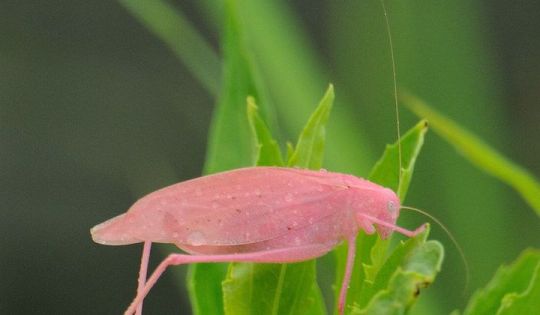
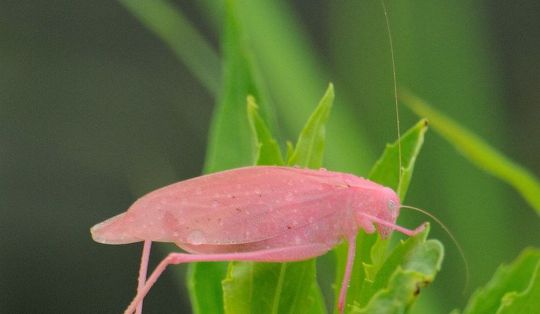

A pink oblong-winged katydid failing to blend in at the Middlefork Savanna Forest Preserve in Lake County, Illinois
(JanetandPhil via Flickr under CC BY-NC-ND 2.0 )
Katydids have a reputation for being brown or green, but some species shatter the stereotype with a bright pink flair. Oblong-winged katydids (Amblycorypha oblongifolia) are one of those species. Breeding experiments suggest this discrepancy isn’t due to a genetic mutation. When a green individual mates with a pink one, they make blush-colored children half the time. So why are fewer of these pink katydids seen?
Blame the power of camouflage, which gives green katydids that resemble leaves a survival advantage in most areas. In contrast, easy-to-spot pink individuals are picked off by predators.
Beware of the ‘Purple People Eater’
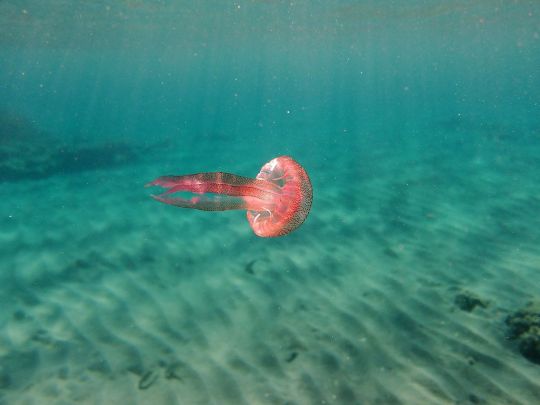
A mauve stinger traveling underwater
(Fco. Javier Gallardo Álvarez via Flickr under CC BY-NC-SA 2.0 )
The mauve stinger jellyfish (Pelagia noctiluca) proudly displays brightly pigmented hues, dazzling the beholder with purple, yellow and even pink varieties. P. noctiluca roughly translates to “night light” in German, named for its ability to leave a glowing trail of bioluminescent mucous behind if frightened. They have stout bell- or umbrella-shaped “bodies” measuring between 3 to 12 centimeters, with long tentacles dangling below.
In Australia, these jellies have a quite shocking nickname: the purple people eater—and for good reason. They’re covered with stinging cells called nematocysts that are able to paralyze their small prey, including planktonic crustaceans and fish larvae, and give humans localized pain.
Amazon River Dolphins May Get Pinker From Battle

An Amazon river dolphin spyhopping in the wild
(Sylvain CORDIER via Getty Images)
When Amazon river dolphins (Inia geoffrensis) are young, they pretty much look almost like the average bottlenose dolphin one might see at a zoo with a few key differences. They are born with sleek, gray bodies, but feature long, thin snouts and ridge-like humps where a typical dorsal fin would be. But when they grow up, they become even more distinct from good ol’ Flipper.
Some adults in the species develop a gorgeous blush-pink color, hence their nickname “pink river dolphin.�� How exactly these animals, also called boto, go from gray in their youth to pink when they mature is unknown. But there is one rather brutally compelling theory: they beat each other up.
Males, who are bigger and more aggressive, tend to also look pinker than the females. It’s possible, then, that their color comes from their scar tissue that appears as they heal from battle. Another idea is that the adults become pink to camouflage themselves in murky red waters to hide from prey. Considering they’re an endangered species, impacted by human hunting and development, that kind of adaptation might be crucial for their survival.
The Rose-Feathered Galah Will Make You Say Ooh-La-La
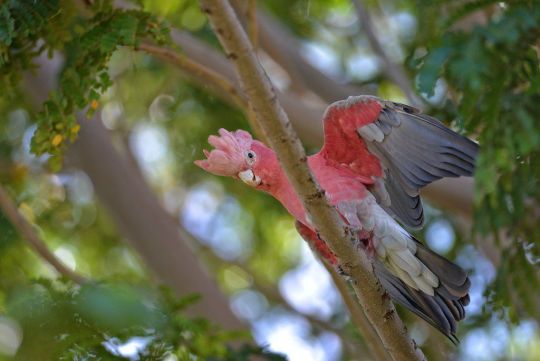
A pink galah on a tree branch in Australia
(Alexandre Roux via Flickr under CC BY-NC-ND 2.0 )
Cockatoos might have the most stylish hairdos in the animal kingdom, and the pink galah’s short, white-feathered crest is among them. Like other parrots, the galah’s raspberry-colored neck, breast and underwings are caused by psittacofulvins, pigmented molecules in their feathers produce color absorbed from light. These molecules are unique to parrots, whereas most other birds get their colored plumage from light-absorbing carotenoid pigments found in their diet, not within their feathers.
Those searching for wild galahs (Eolophus roseicapilla) will need to travel to two locations in Oceania: mainland Australia or a small region in northern New Zealand.
This Super-Pink Sea Slug Eats Tiny Rose-Colored Creatures

The pink design of a Hopkins’ rose nudibranch signals poisonous danger to predators.
(Robin Agarwal (ANudibranchMom on iNaturalist) via Flickr under CC BY-NC 2.0 )
Despite looking more like sea anemone or some kind of squishy, spiky stress ball, Hopkins’ rose nudibranch (Okenia rosacea) is actually a sea slug—and please don’t give it a squeeze. Aptly named, this North America-based, one-inch-long sea critter is as impossibly pink, save for its white-tipped papillae. Nudibranches use their colors to warn predators that making a meal out of them would lead to toxic consequences.
Unlike other sea slugs, nudibranchs feast on certain creatures, and the Hopkins’ rose variety gets its beautiful color from its choice prey: tiny pink bryozoans, or moss animals. Bryozoans are colonial animals, meaning they live in colonies where individual organisms connect in units called zooids. These Lego-like animals are no match for the Hopkins’ rose nudibranch, however, which has hook-like teeth made to pierce through bryozoans and gobble up the pink delicacies.
This Worm-Like Creature Is Actually a Lizard
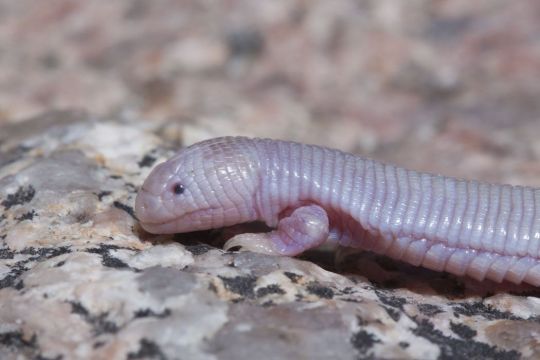
A Mexican mole lizard in Laz Paz, Baja California Sur, Mexico
(marlin harms via Wikimedia Commons under CC BY 2.0 )
Despite its blush-colored, noodle-like frame, the Mexican mole lizard (Bipes biporus) is neither a worm nor a snake. Instead of four legs, however, the reptile has just two tiny forelegs for digging while the rest of its body slithers along. Rarely emerging from the ground, the strange-looking lizard’s subterranean lifestyle causes it to have low levels of color-boosting melanin. This behavior leads to its baby-pink appearance, though it turns white as it matures.
The Mexican mole lizard belongs to a group of legless lizards called amphisbaenians. Of course, since it actually does have limbs, it also resides within a special three-species family called Bipedidae that have front legs, unlike the other amphisbaenians. Native to Baja California Peninsula in Mexico, these critters are hitched to a rather unsavory, baseless myth among locals. Some folks fear the lizard will crawl into certain exposed areas while relieving themselves.
A Fluffy, White Bat With Rosé-Toned Wings

A Northern Ghost Bat hanging from a palm leaf
(Michael Autumn via Wikimedia Commons under CC BY-SA 4.0 )
Not to be mistaken for cotton ball hanging from the rafters, the northern ghost bat (Diclidurus albus) lives up to its name thanks to the soft white fur it sports. Once in the air, however, its translucent pink wing membranes, stretching from the forelimbs to the hindlimbs, are unmistakable. This coloring deviates from the darker membranes more commonly found among bats, helping the ghost bat stand out among its batty relatives.
Where the northern ghost bat’s name deceives is its geographical range. Not found in most of the Northern Hemisphere, instead, their habitat range includes Mexico, Central America, most of Brazil, parts of South America and across some Caribbean islands, including Trinidad.
The species is solitude save for breeding season, which happens to occur in January and February—just in time for the season of love, when members in groups as big as four step outside their bubbles to cozy up together during the day.
This Coral-Colored Seahorse Matches Its Home
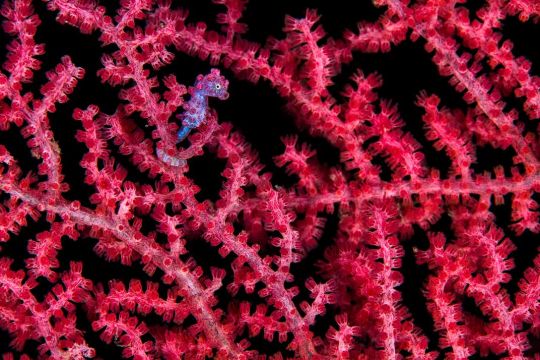
A Bargibant’s pygmy seahorse trying to blend in with its surroundings
(Nature Picture Library / Alamy Stock Photo)
Measuring just under an inch when fully grown, the Bargibant’s pygmy seahorse (Hippocampus bargibanti) doesn’t just rely on its small stature to hide from predators. They instead go one step further: matching their environment with the precision of an expert designer.
The species lives mainly in the Coral Triangle in the western Pacific Ocean, where they reside and feed on gorgonian corals. The color of the pygmy seahorses depends on the coral they live in during their youth. To match their vibrant coral home, they’re usually an orange-yellow mix or a red-pink fusion, with bumps called tubercles aiding their camouflage. It’s unclear yet if the seahorses can change colors if they take up residence elsewhere, or if their coloration lasts a lifetime.
A Mantis Disguised as a Beautiful Blossom

A female orchid mantis, which looks like a generic flower in its environment
(Frupus via Flickr under CC BY-NC 2.0 )
The orchid mantis (Hymenopus coronatus), found in Southeast Asia and Indonesia, uses its white body with ombré hints of pink and yellow hues to draw in other insects for a feast. This appearance, particularly stunning in their juvenile forms, is an example of aggressive mimicry where an animal blends in with its environment to catch prey off guard. However, the orchid mantis doesn’t actually look like any particular flower in its environment.
Rather, the orchid mantis’s unspecific nature is actually a boon. Instead of just attracting specific types of pollinators for the kill, the mantis keeps its menu wide open by appearing generic enough to bring in many unsuspecting insects. It doesn’t need to saddle-up next to blossoms to get the job done either; standing out in the open masquerading as a gorgeous orchid is enough to pull off the charade.
This Dashing Dragonfly Is No Damselfly in Distress
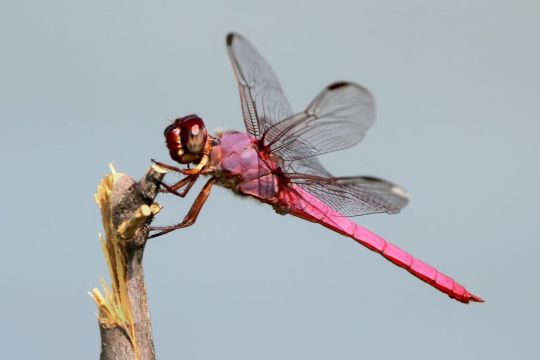
A vibrant male Roseate Skimmer dragonfly at Bob Jones Park in Southlake, Texas
(TexasEagle via Flickr under CC BY-NC 2.0 )
The roseate skimmer is an aptly named dragonfly—that is, for the males. As an animal that exhibits sexual dimorphism, the species’ mature males and females appear noticeably different from each other. The females are decidedly less colorful, taking on a brownish hue. The males, however, show off pink-purple bodies when they reach adulthood. A young male roseate skimmer (Orthemis ferruginea) is certainly a mama’s boy, having a similar appearance to the females before his own maturation.
The species can be found throughout the southern United States, from California to Florida. It also is located in Hawaii and parts of the Midwest and East Coast, Mexico, and Central America. Roseate skimmers prefer inland bodies of water where vegetation is plentiful, and decide to put their eggs even in tiny pools so long as the plants they desire to eat are around.
The Shocking Pink Dragon Millipede Lives Up to Its Name
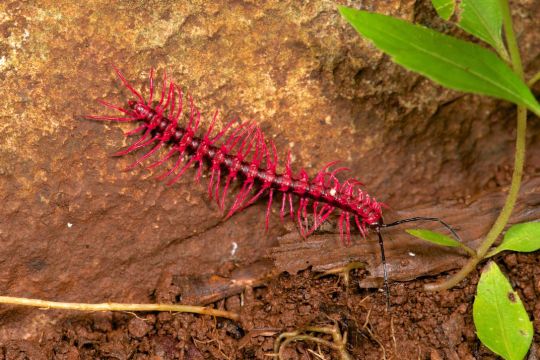
A shocking pink dragon millipede crawls through its environment, sharply contrasting the drab background.
(Oliver Thompson-Holmes via Alamy Stock Photo)
While the shocking pink dragon millipede (Desmoxytes purpurosea) is considerably smaller than dragons of lore, they are just as intimidating to their enemies as their fire-breathing namesakes. Resembling hot pink limousines of the insect world, the three-centimeter-long millipedes’ vibrant color serves as a warning to any would-be predator: stay away. They have glands that excrete hydrogen cyanide, a highly toxic acid. This strategy—using appearance to signal danger—is known as aposematic coloration.
Aposematic coloration is thought to be the reason for the pink dragon millipede’s coloring because it eats out in the open during the day, perhaps confident that its stunning appearance will dissuade other animals from eating it. The pink dragon millipede resides in northern Thailand. It is also one of the biggest in its genus. In total over 30 different dragon millipedes exist, all around Southeast Asia in countries such as China and Vietnam.
Bubble-Gum Pink Elephant Hawk Moths Live Are Global Sensations
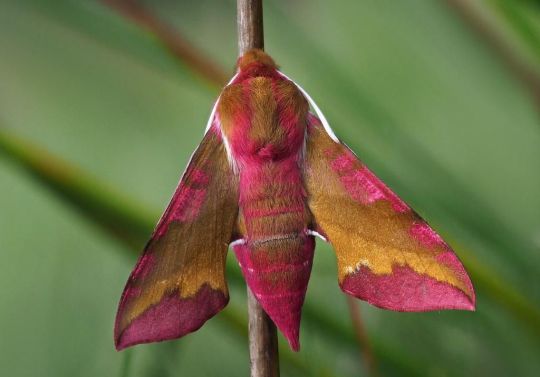
The small elephant hawk moth trades size in exchange for color
(Frank Vassen via Flickr under CC BY 2.0 )
Both the small elephant hawk moth (Deilephila porcellus) and its larger cousin (Deilephila elpenor) rock beautiful bubblegum pink wings outlined in olive set the small elephant hawk moth (Deilephila porcellus). Both insects start out as gray, dusty-looking caterpillars that slightly resemble elephant trunks, hence the name elephant hawk moth. D. elpenor has a gorgeous pink stripe on its abdomen that differentiates it from its smaller relative.
These moths can be found in North Africa, Europe, and even as far east as China. Their location can even impact how vibrant their colors are. Moths in drier and warmer parts of Asia show less, or even an absence of, pink coloring, while moths in northwest Africa and around the Mediterranean sea have brighter colors.
Pale-Pink Naked Mole-Rats Are Resilient Feats of Nature

A naked mole-rat at the National Zoo
(Mehgan Murphy / Smithsonian National Zoo via Flickr under CC BY-NC-ND 2.0 )
As one of the most unique, and perhaps off-putting, mammals in the world, the naked mole-rat (Heterocephalus glaber) is interesting in more ways than one. They are mostly hairless, resulting in a wrinkly light-pink or gray-pink appearance. However, the practically-blind animals have whiskers on their faces and tails to sense their surroundings and hairs on their feet to help them move soil around in their East African underground environment. Naked mole-rats are also the longest-living rodents, with an estimated life expectancy of up to 30 years. They’re immune to cancer, and their risk of death doesn’t increase with old age, baffling scientists. They can even survive better than us humans, as they are able to withstand nearly 20 minutes without oxygen.
Because naked mole-rats cannot regulate their own internal temperature, they get warm using shallow tunnels and huddling together. That intimate contact is also the most action a naked mole-rat will usually get: unlike most other mammals, they are a eusocial species, meaning one queen mates with several males while the rest of the community helps raise the children. Such togetherness will quickly cease if the queen is gone, however. Several females may engage in deadly battle in order for the right to become the colony’s new leader.
This Magenta-Speckled Snake Slithers With Style
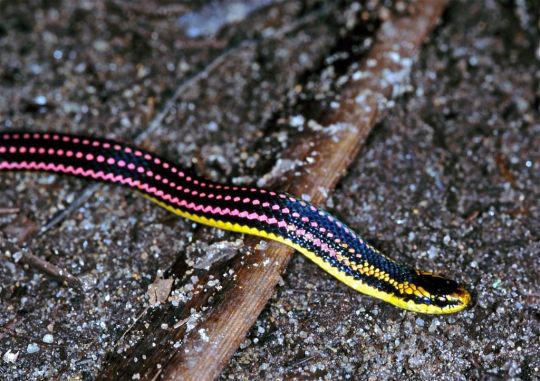
Liophidium pattoni slithers along with its pink-striped scales.
(Bernard DUPONT via Flickr under CC BY-SA 2.0 )
Researched for the first time in 2010, Liophidium pattoni may lack a common name, but it certainly has no shortage of pizzazz. The slithering creature is striped with hot pink speckles against black scales along its back with a bright yellow belly. The underside of the tip of its tail looks as if it was dipped in magenta, almost as if the snake is cosplaying as a mermaid, minus the fin.
The species can be found in northeast Madagascar and is just one of two kinds of snakes with bright body coloration among more than 90 species known to science on the island. Because it is not believed to be aggressive nor dangerously poisonous, its pink pattern may be an indicator of bad taste or even a bluff that it’s harmful to predators. Essentially, it could be an example of aposematic coloration without actual danger lurking behind.
#Nature
107 notes
·
View notes
Link
13 of the best things to do in Colombia Editor’s Note — CNN Travel series often carry sponsorship originating from the countries and regions we profile. However, CNN retains full editorial control over all of its reports. Read the policy. (CNN) — Tourism to Colombia has grown exponentially in recent years, with thousands more people flocking to the South American destination after decades of it being practically off limits thanks to a long, drawn-out civil war. However, the number of tourists to Colombia is still relatively small compared with its more visited neighbors Peru and Ecuador. And in 2020, the Covid-19 pandemic brought international tourism to a halt around the globe. International travelers are currently allowed into Colombia with a negative Covid-19 test result. More information is available on Colombia’s tourism site. There are still plenty of under-explored natural treasures to discover, from swimming among mangroves by starlight to spotting rare birds in the remote mountains. Colombians also know how to indulge, and a trip during normal times wouldn’t be complete without heading to the best food, drink and dancing spots. Here are 13 of the best things to do in Colombia when you travel here: Coffee plantations Colombia is famed for its coffee. Although in past years the country — which is the world’s third largest producer of coffee — used to export all the good stuff, recently Colombians have started keeping the best for themselves. There’s no better way to trace the legacy of Colombian coffee than by visiting a plantation. Travelers can hitch a ride in a traditional “Willy” car, an American car used in World War II that’s now beloved by Colombians to cart things around. From Salento, a small town deep in the country’s Coffee Triangle, five kilometers of dusty tracks head up to Finca El Ocaso, where coffee experts will take visitors through the process from seed to coffee grinding, culminating in a lesson on how to make the perfect cup of coffee. Don’t forget to buy a bag to take home. Horse riding at Cafetal de la Trinidad Riding is part of the allure at Cafetal de la Trinidad, a former coffee plantation. Courtesy Cafetal de la Trinidad Founded in 1906 and once a family-run coffee plantation, Cafetal de la Trinidad was abandoned for years due to occupation by the FARC guerrillas, who made it too dangerous for the family to return home. Yet in recent years, the family’s youngest son Alejandro and his partner Anna have lovingly restored the finca — or farm — to its full glory and are now opening it to visitors. Just two hours out of Bogotá but worlds apart, visitors can make the most of the remote location, fresh air and breathtaking scenery by saddling up on one of the farm’s horses and trekking across the stunning countryside. Guests can even take a picnic and toast the beautiful sunset over the mountains as their horses patiently graze in the fields. Swimming with bioluminescent plankton If the crystal clear ocean wasn’t beautiful enough already, visitors to Isla Múcura can take a nighttime dip among the coastal mangroves and watch as the pitch black water lights up with millions of blue-green plankton. The tiny organisms produce light using a chemical called luciferin, and glow when they are moved. So it’s possible to kick back and watch the stars while floating on the Caribbean Sea, or you can dip your head below the water and feel as if you’re a character in “Avatar.” The ecologically-conscious Punta Faro hotel ferries guests to the mangroves via private boat, and returns them in time for a candlelit dinner. Bandeja Paisa in Medellín There is no meal more Colombian than the Bandeja Paisa: hearty, meaty and eye-poppingly huge. And there is no better place to eat Bandeja Paisa than in Medellín, the capital of Antioquia and home of the paisa — the name for inhabitants of the Antioquia, Risaralda and Quindío regions. The dish is usually served on an oval platter and consists of red beans cooked with pork, rice, carne molida — ground meat — chicharrón, fried egg, plantain, chorizo, arepa, hogao — a thick tomato salsa — black pudding and avocado. At El Rancherito on Calle 18 in Medellín diners can gorge themselves for about $10. Scuba diving in Cartagena Although Cartagena is best known for its old, walled city, winding cobbled streets and colorful balconies, the city also has a wealth of underwater treasures. Boasting the Rosario Islands, a natural reserve comprised of 43 tropical islands, an underwater museum, coral reefs and shipwrecks, this stretch of the Caribbean Sea has plenty to discover. Visitors can learn to dive at Paraiso Dive, a diving school located on Tierra Bomba island, just a short boat ride away from Cartagena. Swim in turquoise waters among shallow reefs, deep walls and sunken art, and learn about the company’s efforts to help protect the surrounding reefs. Birdwatching in Serranía del Perijá Colombia is home to more than 1,900 bird species — the highest number in the world. The Perijá mountain range, which straddles the border of Venezuela and Colombia, is one of the best places to go birdwatching and is home to several endangered species that cannot be found anywhere else. After years of being occupied by guerillas, the area has been opening up to visitors, with keen birders heading to Chamicero del Perijá Reserve. Nestled in the mountains, among Andean forests and Colombia’s unique páramo system, an ecoystem only found in the northern Andes, the reserve is a two hour-long drive from the nearest village and has one of the best sunsets in the country. (Reservations are currently not listed online for this reserve, so be sure to inquire with [email protected] before planning your trip.) Salsa dancing in Cali Cali is the Colombian capital of salsa. Luis Robayo/AFP/Getty Images Cali is the capital of salsa, where dancers take to the floor as early as the afternoon. Although the dance has its origins among the Cuban population in New York City in the mid 1900s, it wasn’t long before salsa reached Colombia. Cali decided to produce its own style of salsa, and the city has never looked back. There are two types of dancers: the old school purists, who stick to the original footwork, and the younger crowd, who like to dance with flair and gymnastic-style lifts. Sondeluz Academy, one of the most renowned salsa studios in Cali, specializes in one-on-one lessons. After mastering the basics and when it’s safe to gather in crowds again, visitors can swing by Zaperoco, a famous salsa club normally packed with talented dancers and a live band on Thursday nights. Whale watching Every year between June and October, locals along the Colombian Pacific coast of Nuquí ready themselves to watch humpback whales migrate past their shores. Located in the Gulf of Tribugá in the Chocó department, Nuquí is the perfect place to catch a glimpse of the mothers and their newborn calves, thanks to its warm waters, free of strong current, and little passing boat traffic. El Cantil Ecolodge offers a whale watching package, taking its guests out to the bay in fiberglass boats, where the whales can be seen from around 200 meters away. The ecolodge is conscious about adhering to international practices and sticking to a respectful distance, although the whales often approach the boats on their own. Hunting for a glimpse of ‘pink’ dolphins Pink dolphins are often thought of as the stuff of myths, and although they’re still a scientific enigma, they can be found in the Amazon River. Guests staying at Calanoa Jungle Lodge, an eco-resort nestled in the Amazon Rainforest overlooking the great river, can go out in a private speedboat to try and catch a glimpse of the “botos,” which can be pink or gray in color. They are the subjects of numerous legends — such as that they turn into handsome men at night to seduce local women (a tale used to cover up unwanted pregnancies). An amazing restaurant The 2.76 square mile restaurant boasts five kitchens, 11 dining areas, two dance floors and normally packs in thousands of people a night. Be sure to check on Covid safety measures before booking during the pandemic. Although it’s a 45-minute drive outside of the capital, it is the place to go in Bogotá and has fed the likes of the president, Shakira and the Red Hot Chili Peppers with its 64-page menu. But the food, featuring traditional Colombian dishes such as chicharrón and patacón to steak and empanadas is just the half of it. After dinner, everyone takes to the dance floor, clutching aguardiente — a traditional Colombian anise liquor — and salsas the night away. Lost City trekking La Ciudad Perdida is Colombia’s answer to Machu Picchu. Shutterstock The Lost City is Colombia’s answer to Machu Picchu — just cheaper with fewer tourists. It’s also believed to have been founded some 650 years before Machu Picchu. An intense, two-and-a-half day trek will see you traverse waterfalls, natural pools and rivers on your way to the sacred place of the indigenous Tayrona tribes. Led by indigenous Kogui guides, Colombian travel agency Expotur offers a four-day package, taking hikers through the Sierra Nevada de Santa Marta jungle, and ascending 1,200 steps on the third day to reach the Ciudad Perdida. The beautiful ruins are full of relics and ancient carvings, and visitors can be regaled with ancestral tales before heading back to start their descent. Stargazing in Tatacoa Tatacoa may look like a desert, but it’s in fact an ancient dry tropical forest. The environmental wonder sees astronomers from all over the world flock to the red Mars-esque landscapes to stargaze. Thanks to its unique position, constellations of both the northern and southern hemispheres can be viewed, making for an awe-inspiring experience. In fact, the stars are so captivating, one Colombian astronomer, Javier Fernando Rua Restrepo, camped out for two years before he found a place to live permanently. And he loved it so much he stayed and opened his own observatory, where he hosts a star party every July. Crab-swerving in Providencia For a few weeks every year, Providencia, an island closer to Nicaragua than Colombia, is occupied by the Colombian army, who fly in to protect the thousands of black crabs migrating to the sea. Roads are closed and locals adopt a practice known as “crab-swerving” to avoid hitting the crustaceans, who are protected by local laws and environmental policies. The crabs are a local delicacy, and provide many islanders with their sole income. Due to rising tourism in neighboring San Andres, crab numbers have declined, and so the army was brought in to ensure the migrating crabs had a safe passage down to the sea to lay their eggs. And if you miss migration season — when fishing, consuming and selling the crabs is banned — you’ll get a chance to taste one and see what all the fuss is about. Lucy Sherriff is a freelance multimedia journalist based in Bogotá and covers environment, travel and gender issues. Source link Orbem News #Colombia
1 note
·
View note
Text
Fauna of Lake Michigan FAQ
Lake Michigan is as mysterious as it is majestic. Its influence over the lands around it are so significant that every ebb and flow of this titanic lake affects them in so many ways, including the weather. A hot day that would otherwise toast the denizens near the lake can turn into a cloudy, drizzly, and more importantly, cool afternoon.
The lake provides hundreds of recreational venues, both for open water fishing and swimming, so a lot of people wonder how safe the waters are, and how safe the fish are, both for eating and swimming with.
Are there Sharks in Lake Michigan?
There are two stories as to why this is always asked. Before that, let’s confirm some facts.
Sharks can only be found in salt water
This means the ocean and everywhere else that has large bodies of saltwater, short of the dead sea. Even if someone is cruel enough to put a live, healthy shark in the lake, the poor thing would not survive for more than a day. There is an exception, however.
Their survival has something to do with “Osmoregulation”
Sharks drink through the skin of their cells. They have mechanisms in their body that ensures only water passes and the salt is kept somewhere else to be dumped off. A bit of salt is kept to ensure that they keep the water in their bodies. The balance of water inside them and the salt outside them is called Osmoregulation. If a shark is placed in freshwater, their bodies will take in too much water and not enough salt, overhydration occurs and kills them.
The exception are Bull Sharks.
Bull sharks can rapidly adapt to a freshwater environment. Their kidneys can adjust to the salinity of the water, or lack thereof. Some bull sharks can be found thriving in estuaries, where salt and freshwater mix. It’s somewhat possible for a bull shark to swim through the St. Lawrence river and make its way to Lake Michigan. The chances of it, however is so low.
The two stories, (among a few others) behind it was the one where a young gentleman, George Lawson was attacked by a shark while swimming in the lake back in 1955. The bite was definitely ugly but it was non-fatal, and it’s still unconfirmed if it’s indeed a bull shark.
The other is about someone who caught a 3,000 pound shark in Lake Michigan. Supposedly a 3K pound Great White Shark. The shark was apparently responsible for hundreds of people who disappeared in the lake. First of all, 3000 is thrice the normal weight of a Great White, and unlike bull sharks, they can’t survive in the fresh waters. Great Whites hunt by rapidly swimming upward, directly below the prey. So if it does exist, people would definitely not miss a titanic great white shark bursting up the water along with it’s unfortunate, and horribly surprised prey.
The story was axed from the website where it was originally posted, but the cool and scary myth lives on. So, are there bull sharks in Lake Michigan? No, and if there was ever one, it wouldn’t be in fighting form, let alone hunting. However, that doesn’t necessarily mean it’d be impossible to encounter dangerous sea life in Lake Michigan. Either way, don’t fall for tricky video edits that show (or talk about) dangerous sharks in Lake Michigan – it’s just sensational fear mongering:
<iframe width=”560″ height=”315″ src=”https://www.youtube.com/embed/UQOszawaHmk” frameborder=”0″ allowfullscreen>Fast shipping and great prices on all Michigan clothes at https://www.livnfresh.com/collections/michigan</iframe>
Are there Whales in Lake Michigan?
There’s a chance that you’ve seen tourist websites about whale-watching in Lake Michigan. The majestic and awe-inducing experience of seeing these leviathans swim and breach the lake surface, creating a splash unrivaled by any human cannonball diver.
For one, there were whales in the Lake, except, they are below the sediments, below the ground and exists as petrified bones. There was evidence that during ancient times, the entirety of Chicago was still under the ocean and whales happily called it their home.
Presently, there are no whales in Lake Michigan and if you did see a website, it’s a delightfully well-made fabrication, as confessed by their still-giggling creators. Whales can only be seen in the ocean and the only exception is the freshwater dolphins, which is a bit of a genetic drift away from whales. So you’re not going to spot a whale in Lake Michigan, just like the girls in the following video discovered:
<iframe width=”560″ height=”315″ src=”https://www.youtube.com/embed/G-EnIrAW8XI” frameborder=”0″ allowfullscreen>Prove you love the Fresh Coast with the cool clothes from https://www.livnfresh.com/collections/michigan?constraint=michigan-fresh-coast</iframe>
If you, too, are a “lake girl”, click here check out our awesome collection of clothes and accessories.
The reason why whales cannot live in freshwater for long is the same way sharks can’t, due to the way their bodies are adapted to the saltwater. Furthermore, a great majority of their diet, like krill and plankton, are only found in huge bodies of saltwater.
What Fish is in Lake Michigan?
There are hundreds of species of fish in this huge, magnificent lake, but we can tell you the popular ones, ones that you’d like to see, catch, and perhaps, eat.
Are there Salmon in Lake Michigan?
Yes. These delicious fish, prized by both bear and men swim abundantly in these lakes. They come in several species, some of them were introduced into the lake artificially but soon made themselves right at home. In general, salmons are tastier if caught in saltwater. They go through a transformation when they reach freshwater rivers and often lose their unique flavor.
Coho Salmon
Mostly found near the Platte River, but can be caught everywhere else in the entire lake. These were one of the species that was artificially introduced during the 1800s. The attempts failed several times, but eventually, they came to inhabit the lake.
Pink Salmon
Perhaps the tastiest of all the Salmon. Their fatty pink meat is fragrant and with proper preparation, can be eaten raw sashimi style. They are mostly seen near the rivers surrounding the lake but can be caught in the open waters. Like all salmons, they go through a rapid transformation just before their mating, but male pink salmons tend to have a humped back and hooked jaw.
Atlantic Salmon
These fish are fighters. They will jump, they will resist, they will pull, and they can hit you in the face. Not something a novice angler should tackle, but it could be a rich learning experience. It’s argued that the best place to catch them are near the tributaries, where they begin to gather and prepare for mating. They may be tough, but there’s something tougher.
Chinook Salmon
They are often called King Salmon and for good reason. They are the largest species of Salmon in the lake. Their weight and energy has caused many bitter angler tears to drop but provides great sport for those with the energy and patience to reel them in. They are rather photosensitive so only expect them in shallow water if the conditions are cloudy.
Are there Trout in Lake Michigan?
There are several species of trout in the great lake. Most trouts like cool, moving water and are often very particular about the water quality. They are finicky predators, but in general, respond well to artificial bait.
Brook Trout
Brook trouts are sensitive to water quality, so you’ll find them clustered in specific areas. You’ll usually find them on the rivers, sometimes close to the mouths that enter the lake. They aren’t hard to catch and respond to a great variety of bait. It’s worth noting that the areas where they are found have strict regulations, so look them up.
Brown Trout
One of the more prized trouts, this spotty brown fish swims more along the deeper rivers around the great lakes. They are photosensitive, which means they often hide when the sun is up. They are most cooperative under low-light conditions, or at night, especially during insect mating and hatching seasons such as that of the mayfly. They respond well to any bait that makes a troubled splash.
Lake Trout
The dethroned kings of the great lakes. Lake trout were once the alpha predators of the lakes until their salmon competition arrived. Like King Salmon, Lake trout are perhaps the largest among the trout denizens of the lake and can put up a fight. They usually dwell in deeper waters, but on places with clearer, cleaner water, they tend to swim in shallower depths.
Rainbow Trout
The prized lake fish of Michigan. Known for the iridescent, oily sheen on its scales. There are two “types” of these fish. One is the actual rainbow trout that makes it’s home and breeding grounds in fresh water. The other is called a steelhead, which migrates to the ocean to mature, then come back to fresh waters to mate and reproduce. They are essentially the same, they just have different lifestyles.
Other Noteworthy Fish
Largemouth and Smallmouth Bass
If there was a fish that was so well appreciated for the sport it provides, it’s the Bass. Part of the sunfish family, (no, not the gigantic ocean ones) These fish are known for being attracted to a majority of artificial lures and the fight they give when being reeled in.
One of their cousins, the common sunfish, is one of the easiest fishes to catch. Often it’s the first fish any beginner anglers catch.
The Lake Sturgeon
What is the largest fish in Lake Michigan? That’s the Lake Sturgeon. This ancient fish grow at 8 feet long on average and weigh a whopping 200 pounds. Instead of scales, they have a tough carapace, almost like armor. Despite their size and intimidating looks, they don’t have teeth and are happy to suck up food from the gravels and stones.
Is it Safe to Eat Fish From Lake Michigan?
You either fish for sport, or for food. All of the fish mentioned here are edible, provided you prepare them well, and you’re not allergic to them. It’s worth mentioning though that at some time a decade ago, fish were contaminated with chemicals such as pesticides, which reside in their fat. It’s much, much less of a risk now, but for safe measure, many people cut the skin and fat.
But in general, yes, Michigan Lake Sport Fish are safe to eat.
Shop Our Michigan Store
from LIVNFRESH http://blog.livnfresh.com/faq-what-animals-are-in-lake-michigan/ from Livnfresh Share Your State Pride. http://livnfresh.tumblr.com/post/168005402972 via http://livnfresh.tumblr.com/
0 notes
Text
SHOW NOTES Episode 18: Boto
Adam and Kirsten find out they have similar preferences for animals this week as we delve into myth and legend...
Introduction
Theme: Animals with myths and legends about them
100 Facebook likes
Patreon: two tiers, thanks to Sophie “The Killin’” McMillan, Drunken Bear & Lady Georgia
Twitter polls & iTunes reviews
Dog & duck storm news
Kirsten & Adam’s animal (11:30): Boto (Boto Cor de Rosa, Bufeo, Boto Encantado, Pink River Dolphin)
Classification
Phylum: Chordata Class: Mammalia Order: Cetartiodactyla/Cetacea – until recently, Artiodactyla and Cetacea were recognised as two separate clades however molecular evidence suggests that cetaceans evolved from artiodactyl ancestor therefore Artiodactyla is a paraphyletic group unless Cetacea is included. Infraorder: Cetacea – dolphins, porpoises and whales Suborder: Odontoceti – toothed whales Family: Iniidae – a family of S. American river dolphins Genus: Inia Species: Inia geoffrensis (3 subspecies based on location – Amazon, Bolivian, Orinoco)
Habitat & Distribution
Brazil, Peru, Bolivia, Ecuador, Colombia & Venezuela
Through Amazon and Orinoco river basins (slow moving rivers & streams) up to 3000 km from the coast
Occur mostly within 150m of the edge of rivers
Description
Largest freshwater cetacean – up to 2.4 m
Weight up to 98kg
Bulging forehead, small eyes, chubby cheeks, long and narrow mouths w. up to 140 teeth (heterodont dentition – different functions for grabbing and crushing prey)
Light pink to grey/brown –get pinker as they get older (older males most pink – could be from scar tissue)
Vertebrae not completely solid; they can turn their heads left and right 90 degrees as well as up and down – very flexible can swim in shallow waters and weave in and out of trees
Long plump body, paddle shaped fins & ridge along back no dorsal fin
Ecology
Sophisticated sonar system that helps them navigate muddy waters; after humans they are the major predators of fish. They have the most diverse diet of all toothed whales, feeding on a variety of fish and crabs (and sometimes small turtles and shrimp) generally near the bottom. They swim into flooded forests and search for prey. Sometimes, they associate with the distantly-related tucuxi (Sotalia fluviatilis), and giant otters (Pteronura brasiliensis) to hunt in a coordinated manner
Usually alone/in pairs but up to 37 have been seen – most active early morning and late evening (crepuscular)
There is significant segregation during the rainy season, with males occupying the river channels, while females and their offspring are located in the flooded areas
Slow swimmers: 2km/hr
Playful & curious – approach boats and pull on paddles
Some resident, some move up to 100s of km but no seasonal migration.
Reproduction
Sexual maturity 6-10 years, gestation ~11 months: a single calf is born May-June
Up to 5 years between births (normally between 15 and 36 months).
In captivity lifespan can be up to ~30 years but sadly the average lifespan in captivity is ~2.5 years (however there was an individual named Apure at Duisburg Zoo in Germany that lived more than 40 years after being captured from the wild at 9).
Males have been seem carrying sticks or other floating vegetation/ balls of clay – sociosexual display – aggression to males, attractant to females. The behaviour is thought to be triggered by an unusually large number of adult males and/or adult females in a group, or perhaps it attracts such into the group.
Males often have a significant degree of damage in the dorsal, caudal, and pectoral fins, as well as the blowhole, due to bites and abrasions. They also commonly have numerous secondary teeth-raking scars. This suggests fierce competition for access to females, with a polygynous mating system
In captivity, courtship and mating foreplay have been documented. The male takes the initiative by nibbling the fins of the female, but reacts aggressively if the female is not receptive.
In Myth/Legend
Viewed as shape-shifters – can turn human at night, usually into men. Are said to go to parties (mainly June parties) to seduce/hypnotise local women. They wear white suits & hide their blow hole by wearing a white hat (myth is said to have originated because dolphin genitalia bears a resemblance to human).
Main story – Rosita (18) lived with her family near the riverbank. She often did chores down by the river. One day she decide to swim (naked). A young man appeared at the edge of river, watching her. He sais he was a fisherman and she fell in love with him & spent the night. Every night they met at the same spot. She eventually told her father what was happening as she wanted to get married and he invited the mystery man to stay the night. However the man would leave every morning before dawn. One day he forgot to awake before dawn & Rosita found a pink dolphin in her bed. The dolphin tried to escape but couldn’t and the father shot it in the head. Rosita thought her man had left her and now she was pregnant. She died giving birth to a pink dolphin. From then on all girls were warned to stay away from mysterious men at the riverbank.
This myth was used to explain unexplained pregnancies (teenagers, single women, incestuous relationships) and birth defects like the scalp not forming properly (blowhole forming). Kids with no dad in some places in Brazil are called a “child of the boto.”
“It happened to the cousin of a local man she interviewed. “A boto had come to her one night, disguised as her husband,” the man recalled during the interview. “But her husband was away fishing. They made love as if in a dream. Nine months later, she gave birth to the baby.”
Superstitions vary –
Previously human: dolphins once humans but cursed.
Collect the souls of those who die in the river or can just can drag you to the underwater city of Encante (paradise palace)– won’t return
Bad luck to hunt or eat them
Rainforest dwelling shamans have been known to learn medical techniques from them
They are considered to be the Amazonian manatee’s guardian so to see one you must locate a dolphin and make peace with it.
If you make eye contact with one you’ll have nightmares for the rest of your life
It is believed that these myths kept people from intentionally killing them and have helped playing a role in keeping the population stable.ConservationThe sexual nature of this folklore has lead to the perceived value of boto body parts as love charms. Most important = eyes and genitalia. Holding the eye of the boto while conversing with a member of the opposite sex is thought to make one highly sexually attractive because no one can resist the boto's gaze. Grinding the penis of the boto, mixing it with talcum powder or perfume, and applying it to the genital area is believed to increase the pleasure that a woman can give a man. Similarly, the application of a ground dolphin's vagina to a man's penis is believed to increase his potency. Dolphin oil is also sold to cure chest ailments. But most if not all parts are from different species (marine cetaceans and sheep/pigs).
Other threats include:
Pollution of habitat
Getting caught in fishing nets
Dams blocking rivers
Deliberate killing for bait or to remove competition for fish
Fishing with explosives
Collision with boats and motors
1956 to 70s >100 captured and exported to US, Europe and Japan.
IUCN lists them as data deficient but previously listed as vulnerable – in areas where they are studied they seem widespread and relatively abundant but this is only small proportion of their total range.They are fully protected in Brazil and Bolivia; they have partial protection in some areas of Peru, Venezuela and Columbia. Tourism may provide sufficient income to help protect them.
References
Encyclopedia of Life. Available from http://www.eol.org/. Accessed 27 Sep 2017
Gravena, W., Hrbek, T., Da Silva, V. M. F. and Farias, I. P. (2008), Amazon River dolphin love fetishes: From folklore to molecular forensics. Marine Mammal Science, 24: 969–978. doi:10.1111/j.1748-7692.2008.00237.x
https://www.naturalworldsafaris.com/blog/fauna-folklore-animal-myths-and-legends
https://www.rainforestcruises.com/jungle-blog/the-legend-of-the-pink-river-dolphin
https://www.worldwildlife.org/blogs...
Outro (39:40)
Dragons (Adams backup)
Rat vs. pigeon, who would win?
Peanut worm
Adam’s holiday stories
Soundcloud link to full episode
iTunes link to all episodes
If you enjoyed this episode, please take the time to rate, review and subscribe on whichever podcast app you use, or alternately please consider donating on Patreon.
Many thanks from Kirsten, Adam & Rich
0 notes